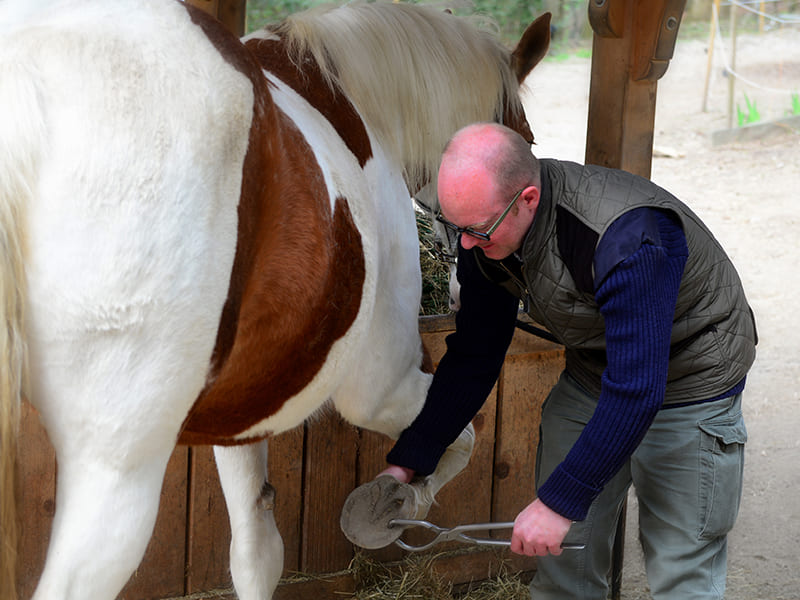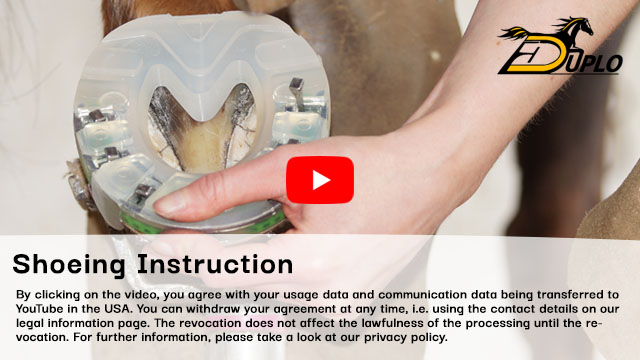Open-Toed Horseshoes with Integrated Grid Sole
go to the online shopOpen-Toed Horseshoes - Support in Rehab Cases, Laminitis and Therapeutic Shoeing in General
The nightmare for every horse owner: Laminitis.
A topic that Wolfgang Busch has delved into very intensively for years.
We are glad to have him on board as a specialist developer and innovator. In collaboration with Wolfgang, we developed the open-toed horseshoe several years ago, which has since been used for many horses with chronic laminitis, as well as various other diagnoses.

Special Features of our Open-Toed Horseshoes
- The open toe area of the horseshoe promotes an early breakover and minimizes the leverage forces in the toe area of the hoof.
-
The front bar is shaped exactly like the dorsal rim of P3.
Like this, there won't be any painful punctual pressure exerted on the rim of P3 if the horseshoe is correctly placed on the hoof. - Every open-toed shoe is equipped with an integrated synthetic grid sole and can be used with liquid or kneadable padding material. Spare padding material can exit through the holes of the grid and won't exert uncomfortable pressure on the sensitive sole.
- Usually, in rehab cases or diagnosis like laminitis, for example, often there is no need to protect the horseshoe from twisting on the hoof; however, if this should be a concern, you can buy a clipped open-toed shoe.
- Thanks to the generous overlap of synthetic material around the metal inlay, the open-toed horseshoe can easily be adjusted to the individual hoof shape.
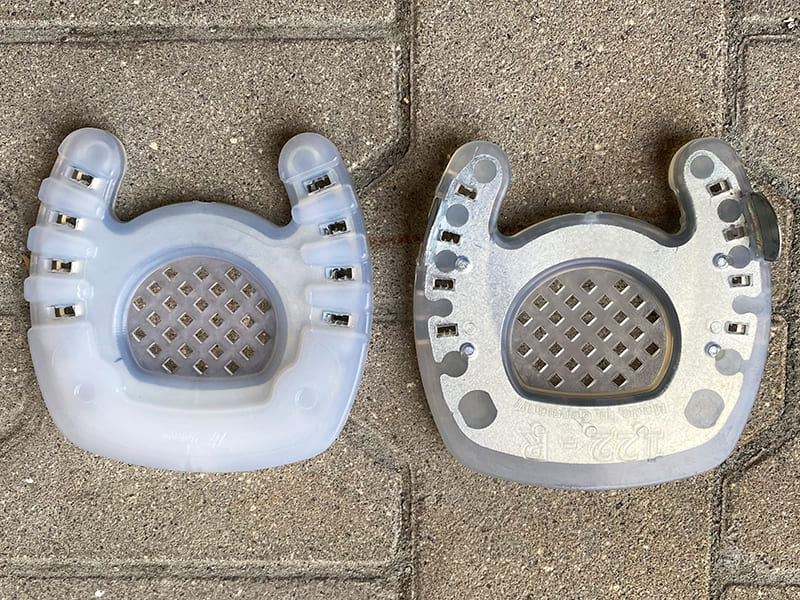


Our Range of Open-Toed Horseshoes - a.k.a. Laminitis Shoe
- Open Toe Horseshoe with Integrated Grid Sole - without additional equipment
- Clipped Open Toe Horseshoe with Integrated Grid Sole - the clips help protect the shoe from twising on the hoof
-
Clipped and Threaded Open Toe Horseshoe with Integrated Grid Sole - The ground surface of all open-toed shoes is slightly
profiled, making the models inherently relatively slip-resistant. However, in certain situations,
the use of
studs may be advisable even for an open-toed shoe. For such cases, there is a threaded model
available.
If you are using the open toe shoe with studs, please consider our safety guidelines regarding the use of studs.
Open-Toed Horseshoes - Photos

The open toe shoes are often referred to as laminitis horseshoes due to their use in cases of laminitis. We offer an un-clipped a clipped , as well as a clipped and threaded version.
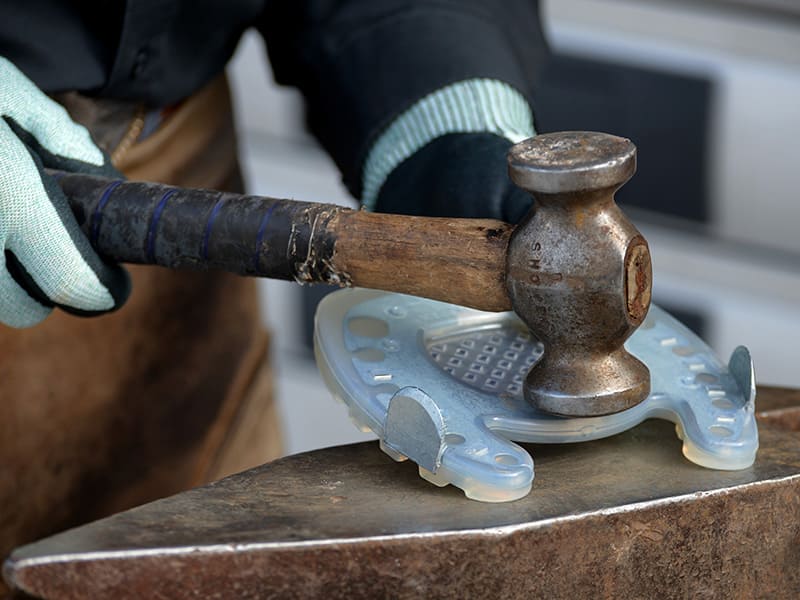
In cases of laminitis, the rotation of the coffin bone can lead to a highly arched sole. To relieve pressure on the deeper coffin bone, the central bar can be modified.
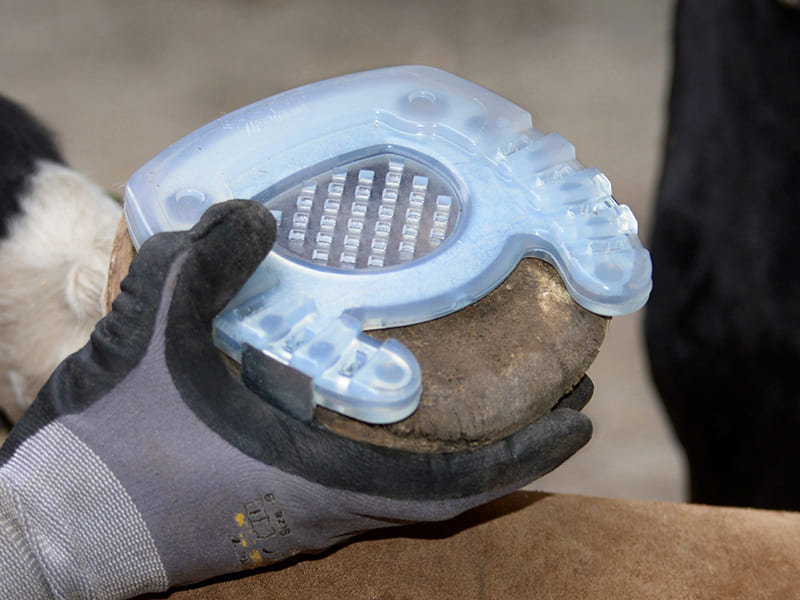
Especially with therapeutic shoeing, such as in the case of chronic laminitis, achieving optimal fit and customization to the hoof is crucial.
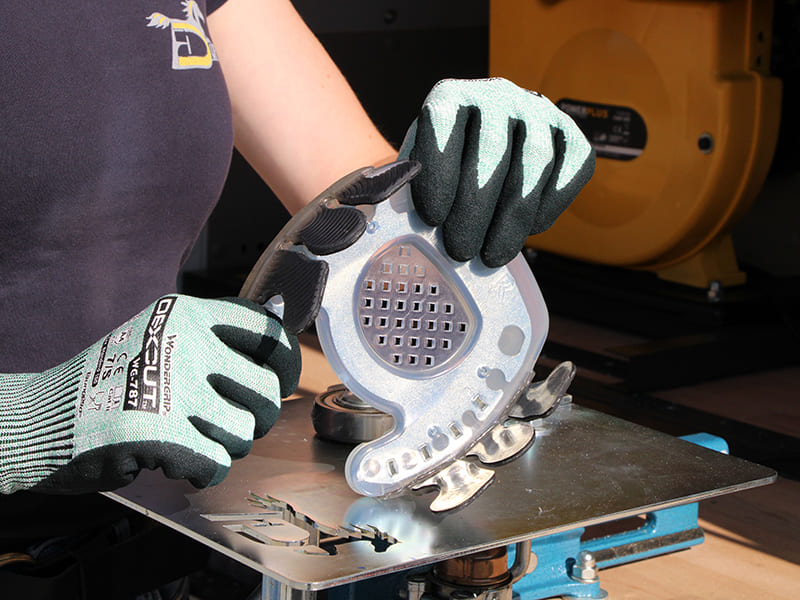
If you intend to glue-on the open-toed horseshoe, we recommend to use our welding device to achieve stable welding seams.

In combination with our open-toed shoe, the Wolf Busch® adhesive tabs work best. Especially in cases of laminitis, a glue-on shoe can be a good alternative.

The advantage of the integrated grid sole is that excess padding material can escape easily through the grid.

A clipped open-toed horseshoe, prepared with cast hooks before applying the cast bandage.

The advantage of our 'cast horseshoe' is that the outsole of the shoe is not covered by the cast bandage.

Please be careful - the coronary band and the heel bulbs must remain uncovered of the cast bandage.
Open Toe Horseshoes - Glue-on, Nail-on and Cast Application Instruction and Safety Information - Video
When using our open-toed horseshoes please pay attention to our safety instructions. Our products are not intended to diagnose or cure any medical condition. Nevertheless, the targeted application of a composite shoe, in coordination with the farrier and/or veterinarian, for example, as part of therapeutic hoof care, can support the recovery process. If you intend to use the open-toed shoe for acute or chronic laminitis, we strongly recommend participating in a training course and cooperating with the responsible veterinarian.
The Advantages of Composite Horseshoes in case of Therapeutic Shoeing
A composite shoe combines the benefits of a traditional steel shoe and a pure plastic shoe in one horsehoe.
The metal parts of the open toe composite shoe are very stable and thus resistant to torsion. They support the hoof precisely where it is necessary. The surrounding plastic shell acts as a shock absorber, thereby partially relieving the sensitive tendons and ligaments of the horse.
A significant advantage, especially in therapeutic shoeing, is the lower weight of the open-toed composite shoe compared to a steel shoe with a central / front bar and a synthethic insole. The reduced weight relieves both the musculoskeletal system and the hoof wall. Additionally, our 'all-in-one' product eliminates the need for elaborate forging work to customize the shoe to the horse's individual needs.
Nailed Application of Open Toe Horseshoes
The rectangular nail holes are positioned at 90 degrees to the white line. That way, you can place the nails further towards the center or the rim of the hoof and individually react to irregular hoof shapes.
In our general shoeing guide, Stephan Becker explains the basic application of our shoes.
Glued Application of Open Toe Horseshoes
If you intend to glue-on a horseshoe and use padding material, avoid excess padding material protruding laterally: Contact between the adhesive tabs and the padding material could compromise the stability of the glued connection between hoof and glue-on tabs.
An area where we prefer to glue-on an open-toed horseshoe is, for example, in the case of chronic laminitis. Wolf Busch® adhesive tabs work particularly well for gluing an open-toed horseshoe.
Cast Application of Open Toe Horseshoes
If you cannot nail nor glue a horseshoe, and the hoof capsule needs to be completely immobilized and stabilized, a cast shoe might be an alternative.
The advantage of our solution for a cast shoe is that the outsole of the urethane shoe is not covered by the cast bandage. This usually extends the durability of the cast shoe. The application of the open-toed horseshoes combined with cast hooks and bandage has demonstrated its effectiveness numerous times.
Every Product Is Only As Good As Its User
The correct application of our composite shoes and accessories is easy if you have the necessary knowledge of and competence in professionally nailing and clinching horseshoes and if you consider certain aspects while doing this.
In the field of therapeutic shoeing, for example, in cases of laminitis, every detail usually matters.
Therefore, we advise that when using our horseshoes as supportive therapeutic shoeing, especially in
cases of chronic laminitis, you attend relevant training courses and further education, and closely
collaborate with the local veterinarian.
We strive to provide you with as much information and tips regarding the application of our
horseshoes. However, all the information provided by us can never replace the direct
evaluation of the horse and its hooves by the on-site professional, to decide, what kind of
shoeing is necessary for the horse.
Product Features
| Model | Open Toe Horseshoe with Integrated Grid Sole |
|---|---|
| Brand | Duplo |
| Additional Title | laminitis horseshoe, open-toed horseshoe, founder shoe |
| Article Number | 730, 740, 750 |
| Function | (alternative) hoof protection, shock absorbtion, supportive as therapeutic shoeing, for example in the case of laminitis (founder), integrated grid sole for use with padding material |
| Riding Styles and Disziplines | Most often, a horseshoe like the toe-open is not intended for use as a riding shoe, especially when apllied with cast hooks and bandage. Of course, our toe-open shoe (nailed of glued-on) is generally suitable for riding when the horse's situation allows for it. However, this applies more to leisure riders than high-performance sports. |
| Rehab & Therapy Shoe | The open-toed shoes are also suitable for supportive use in the orthopedic and therapeutic field; we expressly point out that our products do not diagnose or cure any diseases and advise for any use with a therapeutic or orthopedic background to work closely with the hoof specialist or veterinarian on site. |
| Horse Breeds | a.o. Warmblood, Thoroughbred, Quarter Horse, Paint Horse, Haflinger, Icelandic, Arabian, Friesian, Andalusian, Hanoverian |
| Shoeing | nailed shoe, glued shoe or cast shoe |
| Shoeing Instruction | can be found under FAQ → Instructions |
| Safety Advice | can be found under FAQ → Safety Information |
| made in | Germany |
| Shapes | round |
| Sizes | 110mm, 114mm, 118mm, 122mm, 126mm, 130mm, 134mm, 138mm, 142mm, 146mm, 150mm, 154mm, 158mm, 162mm, 166mm, 170mm |
| Size Interval | in 4mm steps |
| Sizing | Based on the shape of the hoof and the widest part of the hoof (after appropriate hoof treatment) or, in a pinch, also based on the horseshoe size that has fit so far. |
| Season | all year round |
| Weight | depending on the size and version from 230-650g |
| Length | depending on te size - for details please visit FAQ → Sizes and Shapes |
| Width | the respective size in mm |
| the respective size in mm | 15mm |
| Knob Arrays | Our open toe horseshoes do not have any knobs. |
| Solid Metal Inlay | The metal core contributes to the durability of the open toe shoe and helps to avoid unwanted pressure on the hoof. |
| Synthetic Cover | The soft synthethic cover has a shock-absorbing effect. |
| Synthethic bar with metal core | The open-toed horseshoes have a metal bar that provides additional stability and restricts the mobility of the hoof capsule in the heel region. |
| Sole Area | The open toe shoes have a closed sole area. The integrated synthetic grid is suitable for use with padding material. |
| Quarter Clips (depending on the version) | Facilitate the nailing process and help avoiding twists and displacements of the open toe shoe during the regular shoeing period. |
| Toe Area | open toe area |
| Thread Inserts for Studs (depending on the version) | For additional traction, you can buy a clipped and threaded open toe horseshoe. Please pay attention to the safety instructions regarding the use of studs. |
| Thread Size (Heels) | up to size 130mm: M8 from size 134mm: M10 |
| Profile | regular profile |
| Anti-Skid Protection | For additional anti-skid protection you may use spikes or buy the threaded version; when riding, you always have to adapt the speed appropriately to the ground and ride with reduced speed on slippery ground. |
| Nailing Slots | Depending on the size, 6 to 8 nail holes integrated into the metal core. Thanks to the metal core, the nail head cannot slip through the nail hole. |
| Nail Size | The ideal nail size varies depending on the hoof situation and size. You can find a general recommendation in our store at the hoof nails. |
| Risk of Injuries in Herds | Minimized risk of injuries in herd situations and in case of irregular movements in comparison to a steel shoe or the sharp-edged border of a bare hoof - please also read our safety information; the quarter clips must be monitored regularly. |
| Adjustment to the Hoof | with an angle grinder, belt grinder, nippers or toeing knife |
| Breakover | you may bend or grind a toe rocker to adjust breakover |
| Accessories | among others Wolf Busch® glue-on tabs, cast hooks and bandage, instant adhesive, studs, spikes |
| Packaging Unit | sold in pieces |
| Shipment | within Canada - for worldwide shipments please contact the Duplo Team in Germany |
Tips & Tricks - What Are Your Experiences With the Open-Toed Horseshoes
Laminitis, issues concerning the deep digital flexor tendon (DDFT) or its accessory ligament, chronic navicular syndrom, pain in the area of the coffin bone, palmar foot pain, or else... The application areas for the various specialized shoeing methods and types of horseshoes available on the market are diverse and their use should always be discussed individually in close collaboration with the farrier and/or local veterinarian.
Even though every hoof situation is unique in its own way and it's not possible to provide remote diagnoses, it is often invaluable, especially in these specialized areas, to be able to exchange information with others.
We have already received many positive testimonials regarding the use of our open-toed horseshoe in cases of chronic laminitis. However, laminitis shoeing is not the sole application area where the supportive use of our open-toed shoes has proven its worth. We would appreciate it if you could leave us a review at this point, providing others with the opportunity to benefit from your experiences.
